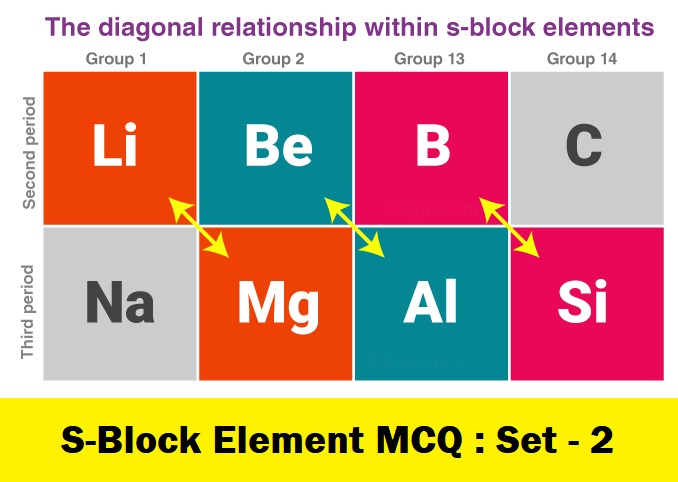CBSE Class 11 Chemistry Chapter 10 The s Block Elements Multiple Choice Questions with Answers. MCQ Questions Class 11 Chemistry The s Block Elements with Answers was Prepared Based on Latest Exam Pattern. Students can solve NCERT Class 11 Chemistry The s Block Elements MCQs with Answers to know their preparation level.
Students who are searching for NCERT MCQ Questions for Class 11 Chemistry The s Block Elements with Answers are compiled here to get good practice on all fundamentals. Know your preparation level on MCQ Questions for Class 11 Chemistry with Answers. You can also verify your answers from our provided MCQ Class 11 Chemistry The s Block Elements with Answers. So, ace up your preparation with MCQ of Chapter 10 Chemistry Objective Questions.
MCQ Questions Class 11 Chemistry The s Block Elements with Answers - Set - 2
Question 1:
Ionization potential of Na would be numerically the same as
(a) electron affinity of Na+
(b) electronegativity of Na+
(c) electron affinity of He
(d) ionization potential of Mg
Correct Answer – (A)
Question 2 :
Which of the following statements is not correct for alkali metals?
(a) Alkali metals are the most electropositive metals.
(b) Alkali metals exist in free state in nature.
(c) These metals have the largest size in a particular period of the periodic table.
(d) Both (b) and (c)
Correct Answer – (B)
Question 3 :
The salt that is added to table salt to make it flow freely in rainy season is
(a) KCl
(b) KI
(c) Ca3(PO4)2
(d) Na3PO4
Correct Answer – (C)
Question 4 :
Milk of lime reacts with chlorine to form ________, a constituent of bleaching powder.
(a) Ca(OCI)2
(b) Ca(CIO2)2
(c) Ca(CIO3)2
(d) Ca(CIO4)2
Correct Answer – (A)
Milk of lime reacts with chlorine to form bleaching powder.
2Ca(OH)2 + 2Cl2 → CaCl2 + Ca(OCl)2 + 2H2O
Question 5 :
The basic strength of which hydroxide is maximum
(a) LiOH
(b) NaOH
(c) Ca(OH)2
(d) KOH.
Correct Answer – (D)
MCQ Questions Class 11 Chemistry The s Block Elements with Answers
Question 6 :
Which of the following has largest size ?
(a) Na
(b) Na+
(c) Na–
(d) Can’t be predicted
Correct Answer – (C)
Question 7 :
Which of the following are found in biological fluids Na+, Mg2+, Ca2+, K+, Sr2+, Li+ and Ba2+
(a) Mg2+, Ca2+, and Sr2+
(b) Na2 +and K+
(c) Na+, K+, Mg2+and Ca2+
(d) Sr+, Li and Ba2+
Correct Answer – (C)
Question 8 :
What happens when Calcium carbonate is heated to 1200 K?
(a) Carbon Monoxide
(b) Calcium hydroxide
(c) Calcium Oxide
(d) Both (2) and (3) are correct
Correct Answer – (D)
Calcium carbonate is strongly heated until it undergoes thermal decomposition to form calcium oxide and carbon dioxide. The calcium oxide (unslaked lime) is dissolved in water to form calcium hydroxide (limewater).
CaCO3 → CaO + CO2
Question 9 :
The hydration energy of Mg2+ is larger than that of
(a) A13+
(b) Na+
(c) Be26
(d) Mg3+
Correct Answer – (B)
Question 10 :
Which of the following alkali metals has the least melting point?
(a) Na
(b) K
(c) Rb
(d) Cs.
Correct Answer – (D)
- NCERT Solutions Class 11 Chemistry Chapter 1 : Some Basic Concepts of Chemistry
- NCERT Solutions Class 11 Chemistry Chapter 2 : Structure Of The Atom
- NCERT Solutions Class 11 Chemistry Chapter 3 : Classification of Elements and Periodicity in Properties
- NCERT Solutions Class 11 Chemistry Chapter 4 : Chemical Bonding and Molecular Structure
- NCERT Solutions Class 11 Chemistry Chapter 5 : States of Matter
- NCERT Solutions Class 11 Chemistry Chapter 6 : Thermodynamics
- NCERT Solutions Class 11 Chemistry Chapter 7 : Equilibrium
- NCERT Solutions Class 11 Chemistry Chapter 8 : Redox Reactions
- NCERT Solutions Class 11 Chemistry Chapter 9 : Hydrogen
- NCERT Solutions Class 11 Chemistry Chapter 10 : The s-Block Elements
- NCERT Solutions Class 11 Chemistry Chapter 11 : The p-Block Elements
- NCERT Solutions Class 11 Chemistry Chapter 12 : Organic Chemistry: Some Basic Principles and Techniques
- NCERT Solutions Class 11 Chemistry Chapter 13 : Hydrocarbons
- NCERT Solutions Class 11 Chemistry Chapter 14 : Environmental Chemistry



